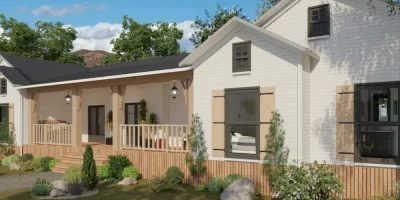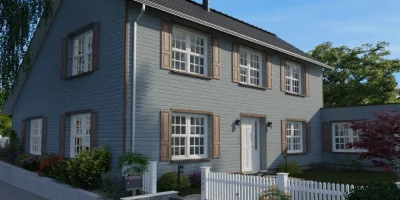In the quest for sustainable architecture, architects and builders are turning more and more to ancient building techniques. It’s really surprising to see how these ancient techniques are inspiring the next generation of eco-friendly designs.
These time-tested methods, which were developed long before modern energy-hungry technologies, have the potential to help tackle some of today’s biggest environmental challenges.
Wondering how you can start implementing these tactics in your sustainable architecture projects?
In this 7-minute read, we’ll…
- Explore five ancient techniques and show how they can help reduce energy consumption, cut down on carbon emissions, and create more resilient, sustainable buildings.
- Give some expert tips so you can start implementing these sustainable building materials and techniques in your projects.
Here they are.
Ancient Techniques Used in Modern Eco-Friendly Architecture
In the past, builders relied more on natural materials like earth and bamboo. Sure, they were readily available. But they also offered natural energy efficiency. Plus, they usually meshed will with the local environment and made the most of local resources. Here’s how 5 of these ancient methods are being re-imagined to create sustainable buildings for a greener future and how you can jump on this trend.
IMPORTANT! – More and more clients have sustainability as a priority and are willing to spend top dollar to achieve it. So in addition to helping the environment, creating a plan to implement these techniques in future projects will also help your bottom line.
Earth Homes
Ancient Technique: Earth homes are structures made from rammed earth or mud bricks and have been around for thousands of years. From desert fortresses in Morocco to cliff-side dwellings in the American Southwest, earth homes are known for their thick walls, which provide excellent insulation. By using the natural thermal mass of the earth, they can regulate indoor temperatures to stay cool in the summer and warm in the winter.
Modern Uses: Earth and mud homes don’t have to stay in the past. Architects are rediscovering the benefits of rammed earth in modern eco-friendly building designs. Homes like these absorb and slowly release heat. That makes them ideal for reducing energy consumption in homes and small commercial buildings. Plus, since rammed earth uses natural materials with minimal processing, it releases fewer carbon emissions compared to normal concrete construction.
Ideas for Your Sustainable Architecture Projects:
- Leverage the thermal mass of rammed earth by designing thicker walls (up to 18 inches or more) to help naturally regulate temperatures. This improves energy efficiency and reduces the building’s dependence on artificial heating and cooling.
- Start small. Test rammed earth or mud brick techniques on small projects such as backyard studios, offices or guesthouses. Use these to refine your techniques and provide proof of concept for future projects in your area.
- Use local soil to cut transportation costs and reduce the project’s carbon footprint. This also helps the structure blend into the natural aesthetic of the surrounding landscape.
- Combine rammed earth building materials with modern eco-friendly insulation materials like straw, cellulose, recycled denim or hemp.
- Incorporate passive solar design principles. This involves positioning your earth home to maximize solar heat gain in the winter and provide natural shading in the summer.
Bamboo Architecture
Ancient Technique: In many parts of Asia, bamboo has long been used as a primary building material. It’s incredibly strong, flexible and bamboo grows quickly. That’s a huge win as far as sustainable architecture goes. Traditional bamboo homes, when designed correctly, can even withstand natural disasters like earthquakes and floods.
Modern Uses: In modern sustainable architecture, bamboo is becoming an eco-friendly alternative to wood and steel. And it’s not just for tropical climates anymore — bamboo is also being used in impressive residential and commercial buildings around the world thanks to its versatility and minimal environmental impact.
Ideas for Your Sustainable Building Projects:
- Explore bamboo as an interior finish. It works beautifully for floors, ceilings and even furniture. It’s got a natural, warm look and it also can improve indoor air quality by avoiding synthetic materials.
- Source sustainably harvested bamboo. This ensures that the material you use is renewable and doesn’t contribute to deforestation or unsustainable farming practices.
- Use bamboo in hybrid designs. Combine it with other sustainable materials like recycled materials or solar panels.
Passive Cooling
Ancient Technique: Residential air-conditioning has only been around for the past 100 years. So how did people beat the heat before before air conditioning? Civilizations like the Persians did it with something called passive cooling. Take the wind towers (Badgirs) as an example. These large, chimney-like structures caught breezes and funneled cool air into buildings while pushing hot air out, all without a single unit of electricity.
Courtyards were also important in ancient architecture. They helped cool interior spaces naturally by providing shaded areas and cross-ventilation.
Modern Uses: Modern sustainable architecture designs incorporate features like cross-ventilation, thermal chimneys, and shaded courtyards to reduce reliance on air conditioning. When you use natural airflow and strategic shading your buildings can stay cooler while cutting down on energy consumption and improving indoor air quality.
Ideas for Your Sustainable Design Projects:
- Design with airflow in mind: Align windows, vents, and other openings to optimize natural ventilation. For example, placing windows on opposite sides of a room can help create a cross-breeze.
- Install thermal chimneys: These work by drawing hot air upwards and out of the building. This also helps pull cooler air to flow in and is especially effective in homes with tall ceilings and open spaces.
- Add courtyards or atriums: Central open-air spaces improve airflow and light. Plus, they become perfect areas for outdoor gatherings. You can also add a water feature like a fountain for evaporative cooling.
Green Roofs
Ancient Techniques: Green roofs go all the way back to the Hanging Gardens of Babylon. And in Scandinavia, people used sod roofs to help insulate their homes. These roofs were practical, provided natural insulation and blended seamlessly into the environment.
Modern Uses: Today, green roofs are becoming a key element in eco-friendly architecture. Why are they becoming so popular? They provide natural insulation, help manage stormwater and reduce the heat island effect in urban areas. Whether you use them for homes or small commercial buildings, a green roof can significantly reduce energy consumption and improve the overall sustainability of the building.
Ideas for Your Sustainable Architecture Projects:
- Use drought-tolerant plants: Plant native species or succulents that need little water and maintenance. This reduces water consumption and also provides a habitat for local wildlife.
- Incorporate a multi-layer drainage system: To prevent water damage and leakage, green roofs need a drainage layer and waterproofing membrane.
- Combine green roofs with solar panels: Boost energy efficiency by pairing solar panels with a green roof (also called “biosolar roofs”). The plants help cool the panels and improve their performance while the panels provide shade for the vegetation.
TIP! – Check out our article on Green Roof Construction to learn more about the benefits and possibilities.
Sustainable Water Management
Ancient Techniques: In today’s modern world, it’s easy to take water for granted. But for ancient cultures it wasn’t as easy as just opening the faucet. That’s why many ancient civilizations were masters of sustainable water management. From Roman aqueducts to the stepwells of India, these systems made efficient use of scarce water resources. Many of them used gravity and natural filtration to capture and store water for months at a time. This helped combat seasonal fluctuations in water availability.
Modern Uses: You can apply similar principles to rainwater harvesting and greywater recycling in sustainable architecture. With water scarcity becoming a very real issue in some areas, these systems reduce a property’s reliance on municipal water supplies. In fact, of the five techniques in this article, this is one of the easiest you can start incorporating in your sustainable architecture projects right away. It’s easy to use rainwater collected from roofs for landscaping. And you can recycle greywater from sinks and showers for toilet flushing.
Ideas for Your Projects:
- Install a rainwater harvesting system: Collect water from your roof in a storage tank and use it for irrigation, toilet flushing, or even laundry. Doing this can significantly cut down on water bills.
- Use greywater recycling systems: Recycle wastewater from sinks and showers to reduce overall water consumption. Large homes and small commercial buildings benefit the most from systems like this.
- Incorporate permeable paving in your landscape design. This lets water seep into the ground and reduces runoff so there’s less strain on local drainage systems.
- Add bioswales or rain gardens: These help to naturally manage stormwater while also adding greenery and aesthetic value.
Start Including Sustainable Features In Your Builds Today
In today’s construction sector, sustainable design isn’t just a fad — it’s quickly becoming the gold standard. Incorporating renewable energy sources like solar panels and wind turbines, using native plants for landscaping, and replacing traditional materials with low-impact, environmentally friendly alternatives are all critical for reducing carbon emissions and meeting modern energy needs.
Cedreo makes it easy for home design professionals like you to visualize and implement these sustainable strategies. With Cedreo, you can:
- Quickly design energy-efficient homes with features like passive systems and solar shading for better interior temperature control.
- Easily integrate renewable energy options such as photovoltaic panels into your designs to reduce energy use and improve sustainability.
- Create 3D visualizations that help your clients see how you can incorporate sustainable materials and eco-friendly features like green roofs into their projects.
Sign up for Cedreo today to see what it can do for your sustainable architecture business!



